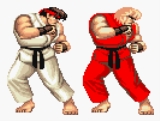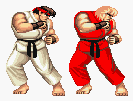
Head swap
Encyclopedia

Video game console
A video game console is an interactive entertainment computer or customized computer system that produces a video display signal which can be used with a display device to display a video game...
s).
Artwork is expensive to produce, so by recycling characters' bodies and only having to draw new heads, studios can save time and money. Early game consoles also had quite limited amounts of memory and storage space for games, so by reusing the body, several characters could be produced with only minimal extra memory requirements. This technique is closely linked to the more common palette swap
Palette swap
A palette swap is a practice used in video games, whereby a graphic that is already used for one element is given a different palette, so it can be reused as other elements. The different palette gives the new graphic a unique set of colors, which make it recognizably distinct from the original...
.
Perhaps the most famous use of the head swap is in Capcom
Capcom
is a Japanese developer and publisher of video games, known for creating multi-million-selling franchises such as Devil May Cry, Chaos Legion, Street Fighter, Mega Man and Resident Evil. Capcom developed and published Bionic Commando, Lost Planet and Dark Void too, but they are less known. Its...
's Street Fighter series. Since the player could not select their character in the original Street Fighter
Street Fighter (video game)
is a 1987 arcade game developed by Capcom. It is the first competitive fighting game produced by the company and the inaugural game in the Street Fighter series...
, the character controlled by the second player, Ken, was made identical to the first players character Ryu
Ryu (Street Fighter)
is a video game player character created by Capcom, the main protagonist of the Street Fighter series. Having premiered in the first Street Fighter in 1987, Ryu appears as the lead character from the game along with his best friend Ken Masters participating in the Street Fighter tournament...
with Kens head, yellow armbands (instead of Ryu's red gloves), and lack of slippers being the only distinguishing graphical features (in addition to his red gi). From Street Fighter II
Street Fighter II
is a competitive fighting game originally released for the arcades in . It is the arcade sequel to the original Street Fighter released in and was Capcom's fourteenth title that ran on the CP System arcade hardware...
and onward, Ryus and Kens fighting styles began to deviate from each other and other head swaps who used variations of their fighting style began to be introduced such as Akuma
Akuma (Street Fighter)
Akuma known in Japan as , is a video game character from the Street Fighter series of fighting games. Akuma made his debut in Super Street Fighter II Turbo as a secret character and hidden boss. In the storyline of the Street Fighter video games, he is the younger brother of Gouken, Ryu and Ken's...
(in Super Street Fighter II Turbo
Super Street Fighter II Turbo
Super Street Fighter II Turbo, released in Japan as , is a competitive fighting game released for the arcades by Capcom in . It is the fifth arcade installment in the Street Fighter II sub-series of Street Fighter games, following Super Street Fighter II...
), Dan
Dan Hibiki
is a video game character from Capcom's Street Fighter series of fighting games. Introduced in Street Fighter Alpha, Dan is consistently portrayed as an arrogant, overconfident, yet utterly feeble character.-Concept and creation:...
(in Street Fighter Alpha) and Sean (in Street Fighter III
Street Fighter III
is a fighting game in Capcom's Street Fighter series, originally released as coin-operated arcade game in . Street Fighter III was produced for the CD-ROM-based CP System III hardware, which allowed for more elaborate 2D graphics than the CPS II-based Street Fighter Alpha games , while revamping...
). Another example is Cammy with Juli and Juni, or Roxy and Poison (Final Fight)
Poison (Final Fight)
is a fictional character in the Final Fight and Street Fighter series of video games. Created by Akira Yasuda for Capcom, Poison first appeared in Final Fight alongside a similar character, Roxy, later appearing in Capcom-produced games, media and merchandise related to the Street Fighter franchise...
.
Head swapping is not the only method of reusing character sprites, as a graphic designer can also change other parts of the body, whether it'll be the character's arms, legs or torso, with new ones to create a new sprite. An example of this would be the final boss in Smash TV
Smash TV
Smash TV is a 1990 arcade game created by Eugene Jarvis and Mark Turmell for Williams. Home versions were developed for various platforms and most were published by Acclaim Entertainment.-Description:...
, MC Mayhen, who uses the same base sprite as the Mutoid Man, but with a different head and chest as well.
The Elder Scrolls IV: Oblivion
The Elder Scrolls IV: Oblivion
The Elder Scrolls IV: Oblivion is a single-player action role-playing video game developed by Bethesda Game Studios and published by Bethesda Softworks and the Take-Two Interactive subsidiary 2K Games...
(and games built off the same engine, such as Fallout 3
Fallout 3
Fallout 3 is an action role-playing game released by Bethesda Game Studios, and the third major installment in the Fallout series. The game was released in North America, Europe and Australia in October 2008, and in Japan in December 2008 for Microsoft Windows, PlayStation 3 and Xbox 360...
) uses a similar technique in order to create the variety of characters necessary to fill the large area the game is set in. Although its characters are three dimensional, it uses sets of predefined bodies and combines them with heads randomly generated from its character customization program.
In Mike Tyson's Punch-Out!!
Mike Tyson's Punch-Out!!
Punch-Out!!, originally known as Mike Tyson's Punch-Out!!, is a boxing video game for the Nintendo Entertainment System developed and published by Nintendo in 1987. It is a port of both the Punch-Out!! and Super Punch-Out!! arcade games with some variations. It has consistently been ranked among...
, each opponent has a head-swapped counterpart, with the exception of King Hippo
King Hippo
is a fictional boxer from Nintendo's Punch-Out!! series. King Hippo first appeared on the Nintendo Entertainment System game Mike Tyson's Punch-Out!!, as the second competitor in the Major Circuit. Hippo also garnered huge fame on the NBC Saturday morning cartoon Captain N: The Game Master, which...
.

